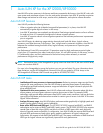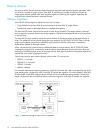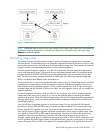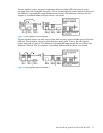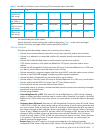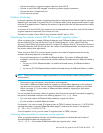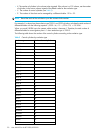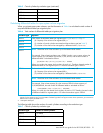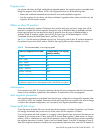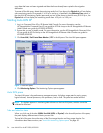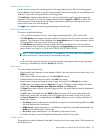
18 Auto LUN XP for the XP12000/XP10000
volume can be used as a source volume. If the status is COPY(SP) or PSUS(SP), the volume cannot be
used as a source volume. This applies to cascaded and non-cascaded volumes.
Table 3 shows which non-cascaded volumes can be used as source volumes.
Table 4 shows which cascaded volumes can be used as source volumes.
If any of the following operations are performed on an Auto LUN XP source volume during migration, the
Auto LUN XP volume migration process stops:
• Continuous Access XP operations that change the volume status to something other than PSUS, PSUE, or
SMPL
• BC operations that change the volume status to COPY(SP) or PSUS(SP)
• Continuous Access XP Journal operations
• Continuous Access XP Journal or Universal Replicator for z/OS® operation that changes the volume
status to COPY.
LUSE source volumes
To specify a LUSE source volume for migration, specify individual LDEVs within the LUSE volume (for
example, LDEVs with high usage). Auto LUN XP migrates only specified LDEVs. If needed, specify all LDEVs
of the LUSE volume to relocate the entire LUSE volume. In this case, ensure that the required reserved target
LDEVs are available.
Target volumes
Target volumes must be reserved prior to migration. Hosts cannot access reserved volumes. The following
volumes cannot be reserved:
• Logical Unit Size Expansion (LUSE) volumes
• Volumes set as command devices
• Volumes assigned to BC or Continuous Access XP pairs
• Volumes reserved for BC operations
• Volumes with Cache LUN data stored in cache
• iSCSI volumes (for example, volumes to which paths are defined from iSCSI ports)
• Volumes in abnormal or inaccessible conditions (for example, fenced)
• Volumes Continuous Access XP Journal uses
• Volumes specified with the Read Only or Protect attribute
• Volumes that Volume Security disabled for use as secondary volumes
• Volumes that LUN Security XP Extension specified as Read Only or Protect or disabled for use as
secondary volumes
Table 3 Non-cascaded volumes that can be used as source volumes
Pair configuration Use P-VOL as source volume Use S-VOLs as source volumes
Ratio of P-VOL to S-VOLs is 1:1 Yes Yes
Ratio of P-VOL to S-VOLs is 1:2 Yes Yes
Ratio of P-VOL to S-VOLs is 1:3 No Yes
Table 4 Cascaded volumes that can be used as source volumes
Pair Configuration Use P-VOL as source volume Use S-VOLs as source volumes
L1 pair, ratio of P-VOL to S-VOLs is 1:1 Yes Yes
L1 pair, ratio of P-VOL to S-VOLs is 1:2 Yes Yes
L1 pair, ratio of P-VOL to S-VOLs is 1:3 No Yes
L2 pair, ratio of P-VOL to S-VOLs is 1:1 Yes No
L2 pair, ratio of P-VOL to S-VOLs is 1:2 No No




